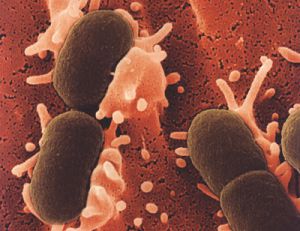Dr. Ketan Desai
By now, everyone now knows what weapons of mass destruction are. They fall into three categories – nuclear, chemical, and biological weapons. Of the three, I consider biological weapons to be the most dangerous. To get a better perspective, consider plague and smallpox. The former, inadvertently launched by the Tartars in 1348, decimated 30 per cent of European population within 3 years. Smallpox was even more deadly, causing the deaths of 90% of Mayans and Aztecs, enabling the Spanish to conquer the ‘new world”.
The potential of biological weapons has not been ignored by armies of the world. Between World War I and ratification of the Biological and Toxins Weapons Convention, it is estimated that at least 20 countries had biological weapons program. The reasons are not hard to understand. Biological agents are easy to make, merely requiring a laboratory on par with what is found in most universities today, and can be created by any graduate student. They are not resource intensive, and most ingredients are easily available. This is in marked contrast to nuclear weapons which are very expensive to make, require radioactive precursors that are under the tight supervision of international agencies, and require technology that are not easy to come by. This is why, despite intense efforts, only a few countries in the world possess nuclear weapons.
Biological weapons have additional attractiveness, in that they can be tailor made, based on the requirements of the “manufacturer”. In order to understand this point, it is important to differentiate between bio-terrorism and biological warfare. The former includes agents designed to spread terror but with limited number of deaths. A perfect example of this is the ‘anthrax scare’ in the US in 2001, where the amount of fear far exceeded the number of those affected. In contrast, biological warfare uses agents that have the potential to cause large number of deaths, numbering in the hundreds of thousands or millions.

Thus, a perpetrator of bio-terrorism would chose diseases such as anthrax and botulism, with agents that are not self-replicating (so as to limit spread) but which have a high lethality (to increase fear). Think of it as a “biological Unabomber”. While dangerous to those exposed, this is a limited threat.
In contrast, biological weapons tend to be self-propagating agents (to increase spread) that are inhaled (to increase dispersal) and one which are made resistant to antibiotics).
“In light of the September 11 tragedy, we can no longer afford to be complacent about the possibility of biological terrorism,” warns a commentary in Nature Genetics. “The revolution in biology could be misused in offensive biological weapons programs, directed against human beings and their staple crops and livestock.”
Thus, the next generation of biological weapons may exploit knowledge about genomes, with calamitous effect. A couple of years from now, there may be as many as 70 pathogens whose genetic code has been cracked. The genome of cholera, leprosy, the plague and tuberculosis are already in the public domain, as is Staphylococcus aureus that is becoming resistant to antibiotics. There is fear that a bioterrorist with lots of money and a good laboratory could use this readily available data, inserting or swapping genes in bacteria and viruses to create new, horrifyingly virulent agents.
There are at least two documented cases in which biologists have created doomsday bugs. One was a strain of the common intestinal bug Escherichia coli that was 32,000 times more resistant to the antibiotic cefotaxime than conventional strains. The superbug’s creator was Willem Stemmer, chief scientist with Maxygen, a California pharmaceutical research firm, who was exploring the function of resistance genes in bacteria. The technique used, DNA shuffling, involves shattering multiple copies of a gene and then reassembling them. The process produces a range of daughter genes with the fragments stitched together in subtle but new ways. The enzymes involved in the re-assembly are prone to errors, leading to mutations and, therefore, greater diversity. The daughter genes can then be re-introduced into the bacteria and the resultant bacteria with the desired strains (such as those good as biological agents) selected. Fragments from different bacteria can be mixed and matched by this technique. Needless to say, the potential of this in the wrong hands is enormous. In response to an appeal by the American Society for Microbiology, the E.coli created by Stemmer was destroyed.
In another example, Australian scientists Ron Jackson and Ian Ramshaw unwittingly created a vicious strain of mousepox, a cousin of smallpox. They were attempting to control the population of mice by altering the genes of mousepox to make it more lethal. To create their mouse contraceptive, they took a relatively benign strain of mousepox and added genes for proteins carried on the surface of mouse eggs. The idea was that cells infected by the viruses would churn out egg proteins, causing female mice to produce antibodies against their own eggs. To maximize the vaccine’s effectiveness, Jackson and Ramshaw also engineered the virus so that it contained the gene for interleukin 4, a cytokine that boosts anti-body production. The IL-4 gene also shut down the mice cellular immune response so they were unable to fight off the virus. The effect was lethal, with mice that were previously immunized against mousepox dying within days. The implications are obvious and profound.
Two kinds of people would use such weapons. The first could be nihilists and anarchists, who find all aspects of modern society despicable and feel they need to start all over again. Such persons could create a recombinant agent (such as a virus) that could literally destroy society as we know it. Unfortunately, such an agent would not be hard to create. For example, HIV-1 could easily be inserted into Adenovirus (after removing the dispensable E3 gene of the latter) creating inhaled AIDS. Needless to say, such a creation would be devastating.
The other perpetrators of biological warfare could be terrorists groups such as Al Qaeda. Groups such as this could gamble that even though biological warfare would hurt them as much in the end, it would level the playing field, where they have the long term advantage (in their view, thanks to their fanaticism). A tactic they could use is to select agents to which they are relatively immune while the Western world is relatively naïve. This can be created by insertion of antibiotic resistant genes or genes that selectively attack certain racial groups (in another article, I will show how such agents can be created). Given the jihadi mentality, such groups will consider their own mortality as martyrdom, while those of the enemy as the ultimate goal.
============
Diseases/Agents Listed as Potential Bioterror Threats by the US Centre for Disease Control and Prevention (CDC)
CATEGORY A: Easily disseminated; high mortality rates.
Bacteria (single-celledorganisms):
Anthrax (Bacillus anthracis)
Plague (Yersinia pestis)
Tularemia (Francisella tularensis)
Viruses:
Smallpox (Variola major virus)
Viral Hemorrhagic Fevers: Ebola, Marburg,
Lassa, Machupo (various families of viruses)
Biotoxins (poisonous substances produced by living or ganisms):
Botulism (Clostridium botulinum toxin)
CATEGORY B: Moderately easy to disseminate; low mortality.
Bacteria:
Brucellosis (Brucella species)
Glanders (Burkholderia mallei)
Melioidosis (Burkholderia pseudomallei)
Psittacosis (Chlamydia psittaci)
Food safety threats (e.g., Salmonella species, Escherichia coli O157:H7, Shigella)
Water safety threats (e.g., Vibrio cholerae, Cryptosporidium parvum)
Viruses:
Viral encephalitis (Alphaviruses)
Rickettsia (micro-organisms that live in cells)
Qfever (Coxiella burnetii)
Typhus fever (Rickettsia prowazekii)
Biotoxins:
Epsilon toxin of Clostridium perfringens
Ricin toxin from castor beans
Staphylococcal enterotoxin B
CATEGORY C: Emerging infectious diseases.
Viruses:
Examples are Nipah virus and Hantavirus
Coronaviruses


















